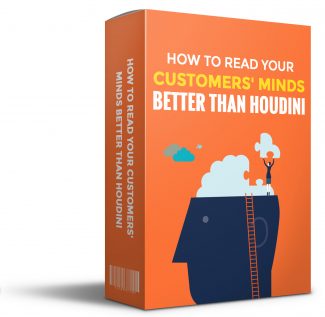
 License Type: Giveaway Rights
License Type: Giveaway Rights  File Type: ZIP
File Type: ZIP
 SKU: 60132
SKU: 60132  Shipping: Online Download
Shipping: Online Download
Ebook Sample Content Preview:
How To Read Your Customers' Minds Better Than Houdini
Common advice to new marketers is to find a need and fill it. Better advice is to find a want and fill that, since people more readily spend money on things they want than they do on things they need. After all, no one NEEDS an expensive car. Even the cheapest of automobiles will get them where they want to go – yet people WANT the high end cars and they pay dearly for them.
So we know to find needs and wants and to fill them. And we've all been told to do surveys or haunt forums to find out what these needs and wants are. It's very basic advice and if you combine it with some trial and error, it will usually get the job done, at least to a certain degree.
But what if you want a blockbuster smash-it-out-of-the-park product?
Something that you can perhaps retire on?
Then you're going to have to upgrade your methods of product research and product creation. In fact, what you'll need to do is focus on something called Customer Development, and according to Steve Blank, it goes like this:
1. Understand your customers' problems and needs
2. Prove that you have a repeatable sales model (for long term sales and income)
3. Create and drive end user demand (also known as marketing)
4. Building – that is, transition from learning what your customers want to executing on what you've learned.
It's that first step - Understanding your customer's problems and needs – that sets the stage for the other 3 steps and your eventual long term success. And it's also the step most people get wrong.
You probably already have a vision for a new product. You've looked and needs and wants and you've got a solution you want to offer customers. The unseasoned marketer will now create the product and offer it to customers, something you might call the sink or swim method. But since 9 out of 10 products sink using this method, I'm going to suggest you do the following instead:
1. Go talk to the people who you believe are potential users for your product. Your goal is to see if there is a direct match between your product vision and what people want.
2. If you're finding out there isn't a match, you make one of two changes. Either you change your product to what these particular customers do want, or you find a different segment of the market that does want what you are planning to offer.
3. Your goal is to understand the problem your product is addressing. Ask people how they handle this problem now and if they perceive it as being a an important issue for them. Forget yes and no type questions.
Instead, ask open ended questions such as,
“If you could change anything about the way you deal with this problem, what would it be?”
“How do you currently solve this problem?”
“Can you describe the problem in your own words?”
“Have you tried other solutions? What happened?”
“What do you wish you could do to solve this problem?”
“Tell me about the last time you had this problem.”
“How much does this problem cost you?”
NOTE: Don't ask hypothetical questions because they won't be relevant or helpful. Don't ask for features, don't try to convince or sell and don't try to solve their problem. For example, don't ask:
“Do you like this idea?”
“Would you buy this?”
“How much would you pay for this?”
4. Adjust accordingly. You might uncover an even larger, more pressing problem that you can solve for these customers. Don't be afraid to discard a good idea for a great idea. In other words, don't chase after crumbs if turning in another direction will provide a feast.
5. Build, Measure and Learn, but not necessarily in that order. Figure out what you need to learn. For example, will people use your XYZ service if it's free. Then figure out how to measure that. In this case, you can track sign-ups for a beta service you will be introducing. Then you decide what you need to build. And in this case, all you need is a landing page to sign people up, with either a description or a video showing what your service will do.







